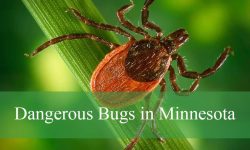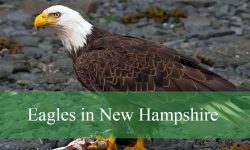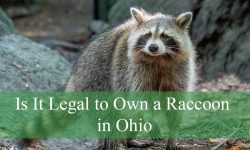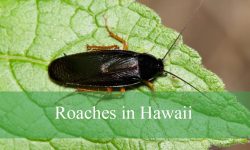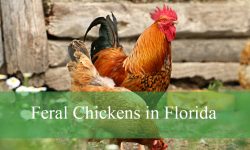Yellow Birds in Virginia add vibrant splashes of color to the state’s diverse landscapes. From forests to wetlands, these bright feathered friends brighten every season and delight birdwatchers across the region.
Identifying Yellow Birds in Virginia can be both fun and rewarding. Each species has unique markings, behaviors, and habitats that make spotting and recognizing them a special experience. Beginners and experienced birders alike will find this guide helpful for learning about these stunning birds.
In this article, we explore 39 Yellow Birds in Virginia with clear pictures and detailed identification tips. Get ready to discover fascinating facts about each bird and where to find them throughout the state.
American Goldfinch
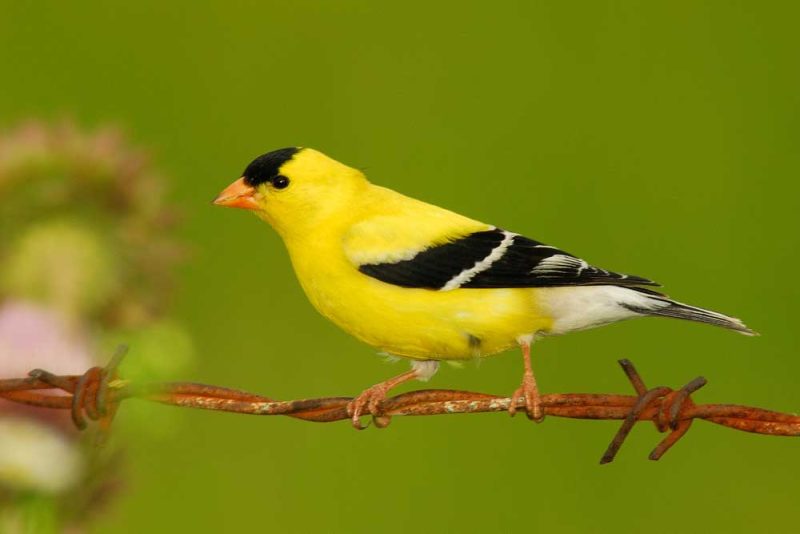
The American Goldfinch is a small, vibrant songbird recognized by its bright yellow plumage and black wings with white markings. Males display vivid yellow feathers in summer, while females and winter males appear more subdued in olive or brown tones. This species measures about 4.3 to 5.1 inches in length, with a wingspan ranging from 7.5 to 8.7 inches, and has a distinct conical bill suited for seed eating.
In Virginia, the American Goldfinch is active year-round and especially noticeable during the breeding season when males sing from perches to defend territory. These birds exhibit undulating flight patterns and often gather in small flocks outside of nesting season. They breed later in the summer than many songbirds, timing nesting with the peak of seed availability.
American Goldfinches thrive in open habitats such as meadows, fields, gardens, and woodland edges across Virginia. They primarily feed on seeds from thistles, sunflowers, and asters, though they may also visit backyard feeders for nyjer or black-oil sunflower seeds. Their presence is widespread throughout the state, including in suburban areas where natural seed sources are abundant.
American Redstart (Female)

The female American Redstart is a graceful warbler with subdued coloring compared to the male. She is olive-gray above with yellow patches on her wings, tail, and sides. Smaller in size than many warblers, females typically reach 4.3 to 5.1 inches in length. Her sharp, slightly curved bill is perfect for catching small insects.
Unlike the male’s striking black and orange pattern, the female blends better into the foliage. Despite her subtle coloration, she is agile and active, often flashing her tail to flush out insects from leaves. In Virginia, the American Redstart can be seen during the breeding season in spring and summer, especially in wooded habitats near water.
These warblers forage by darting between branches and sallying out to snatch insects mid-air. They favor deciduous forests, forest edges, and streamside woodlands across Virginia. While common in the Piedmont and mountain regions, they also migrate through coastal areas. Their diet consists primarily of insects such as flies, moths, and caterpillars.
American Yellow Warbler

The American Yellow Warbler is a bright yellow songbird with golden tones all over its body and subtle reddish streaks on the chest, more prominent in males. It measures around 4.7 to 5.1 inches in length and has a short, sharp bill adapted for picking insects off leaves and branches. Both sexes are uniformly yellow, making them easier to identify in the field.
In Virginia, these warblers arrive in late spring and are active throughout the summer breeding season. Males sing a sweet, whistled song from shrubs and small trees to attract mates and mark territory. Yellow Warblers are known for their aggressive defense of nests and will build new ones on top of cowbird eggs laid in their own nests.
Their preferred habitat includes thickets, willow groves, wetlands, and shrubby areas near water. They are commonly seen across the state, from the Coastal Plain to the Blue Ridge and Valley regions. Their diet is almost exclusively made up of insects like beetles, caterpillars, midges, and wasps, which they hunt by gleaning and short flycatching.
Baltimore Oriole (Female)
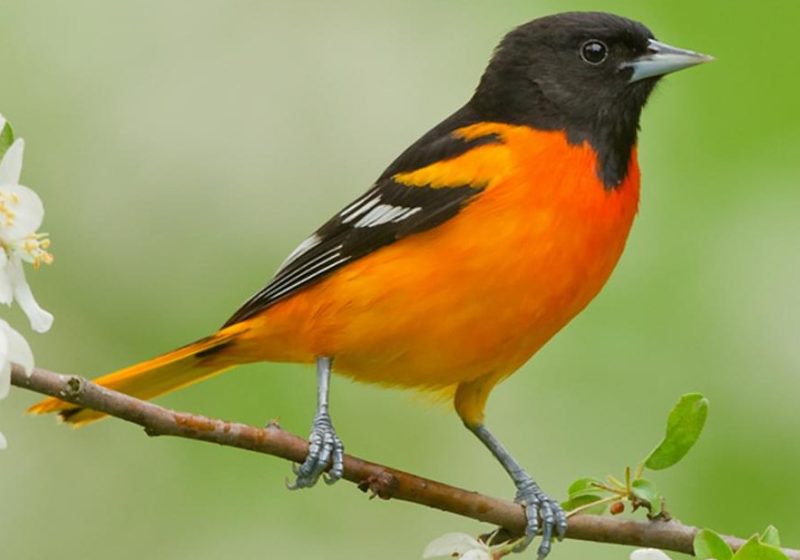
The female Baltimore Oriole is more modest in appearance than the male, showcasing yellow-orange underparts and duller olive-gray on the back and wings. She also sports two pale wing bars and a slightly curved bill. Females range in size from 6.7 to 7.5 inches in length, with a wingspan of about 9 to 12 inches.
In Virginia, Baltimore Orioles are seasonal visitors, seen from late April through early fall. Females build intricate, hanging nests from fibers and grasses, often suspending them high in deciduous trees. While not as flashy as males, they are just as vocal, producing a range of whistles and chatters during the breeding season.
They prefer open woodlands, suburban neighborhoods with mature trees, and riverbanks. Orioles feed on insects, fruit, and nectar, often visiting backyard feeders stocked with orange halves or grape jelly. In Virginia, they are more frequently observed in the eastern and central parts of the state during the warmer months.
Black-throated Green Warbler
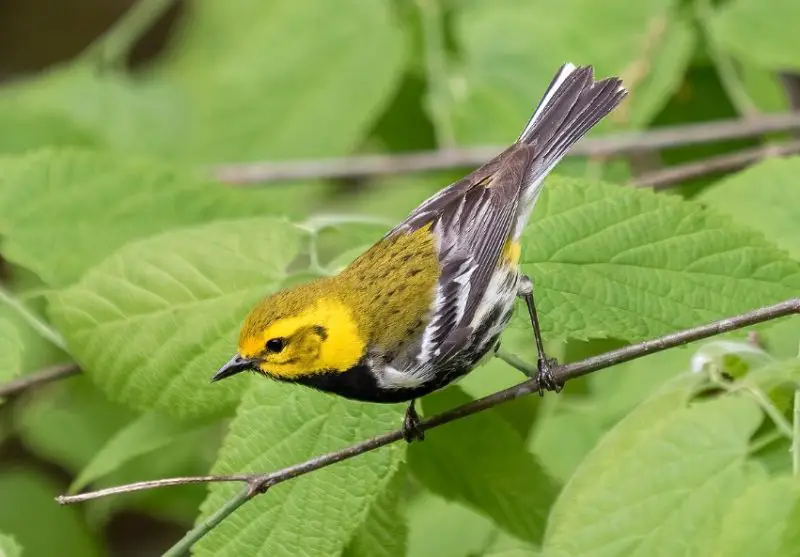
The Black-throated Green Warbler is a small, vibrant songbird known for its striking black throat, bright yellow face, and olive back. Measuring around 4.3 to 4.7 inches in length, it features white underparts with black streaking on the flanks. Males are especially bold in coloration, while females have a lighter throat.
These warblers are primarily seen in Virginia during spring and fall migration, although they also breed in higher elevation forests in the western part of the state. Males are easily identified by their repetitive “zoo-zee-zoo-zoo-zee” song, which they sing from high perches in coniferous or mixed woodlands.
They forage actively among needles and branches, picking insects like caterpillars, spiders, and beetles. The Black-throated Green Warbler prefers mature forests, especially those with hemlock or spruce, and can be spotted in the Blue Ridge Mountains and Shenandoah region during breeding season. Migration sightings occur across the entire state, including in coastal woodlots.
Blue-winged Warbler

The Blue-winged Warbler is a small, colorful warbler recognized by its bright yellow body, olive-green back, and bluish-gray wings with distinct white wing bars. A narrow black line through the eye adds definition to its face. Measuring about 4.3 to 4.7 inches in length, it has a thin, pointed bill ideal for picking off insects.
In Virginia, Blue-winged Warblers are most commonly seen in spring and summer during the breeding season. Males sing a distinctive buzzing “bee-buzz” song from low shrubs to mark territory. These birds are active and agile, often hopping through dense brush and occasionally performing short aerial sallies to catch insects.
They prefer shrubby fields, regenerating forests, overgrown pastures, and powerline cuts—especially in the Piedmont and Appalachian foothills of Virginia. Their diet includes caterpillars, spiders, and other small insects, which they glean from leaves and twigs. While their range overlaps with the Golden-winged Warbler, hybridization is rare in Virginia.
Canada Warbler
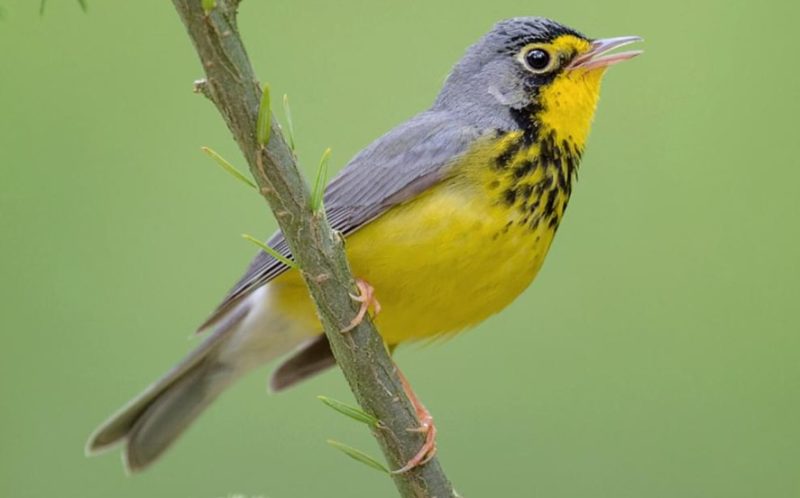
The Canada Warbler is a striking species known for its slate-gray upperparts, bright yellow underparts, and a bold black necklace across its chest. It also features a white eye ring and a long tail, giving it a distinctive look. These birds measure about 4.7 to 5.9 inches in length and have a quick, darting movement style.
In Virginia, the Canada Warbler is mainly a migrant, though it breeds in the cooler, higher elevations of the Allegheny and Blue Ridge Mountains. During migration, they pass through the state in late spring and early fall, often seen flitting low in forest undergrowth. Their song is fast and varied, typically ending in an upward slur.
They prefer moist, mixed forests with a dense understory of rhododendron, mountain laurel, or ferns. While in Virginia, they feed on a variety of insects, especially during migration, gleaning from leaves and capturing prey mid-air. This species is considered a conservation concern due to habitat loss in both breeding and wintering grounds.
Cape May Warbler
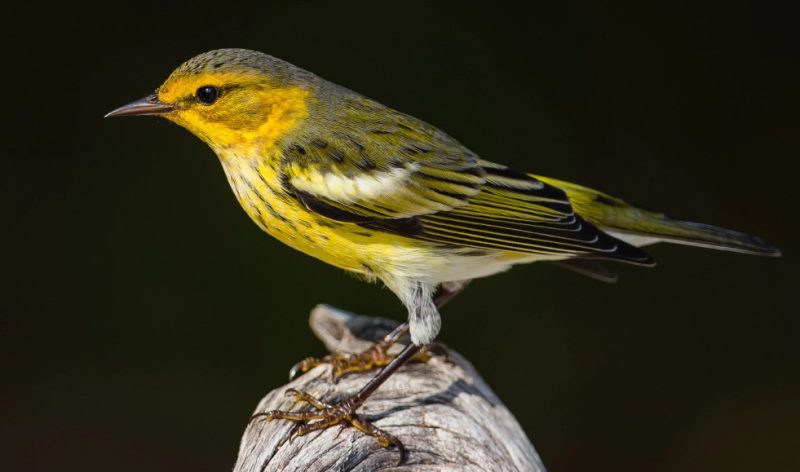
The Cape May Warbler is a beautifully patterned warbler with a streaked yellow chest, chestnut cheek patch, and a fine black eye stripe. Males are more brightly colored, while females appear duller with less contrasting markings. This warbler is relatively small, about 4.3 to 5.1 inches in length, and has a slightly decurved bill.
In Virginia, the Cape May Warbler is mostly a migrant, passing through during spring and fall as it travels between its northern breeding grounds and Caribbean wintering sites. They are often spotted in treetops but will also descend to lower branches in parks and wooded neighborhoods. Males sing a high-pitched, lisping song.
Their preferred habitat includes spruce and coniferous forests at higher elevations during breeding, but in Virginia, they can be found in a variety of wooded areas during migration. Their diet is made up of insects, especially spruce budworm, and nectar, which they sip using their tubular tongue—a rare trait among warblers.
Cedar Waxwing
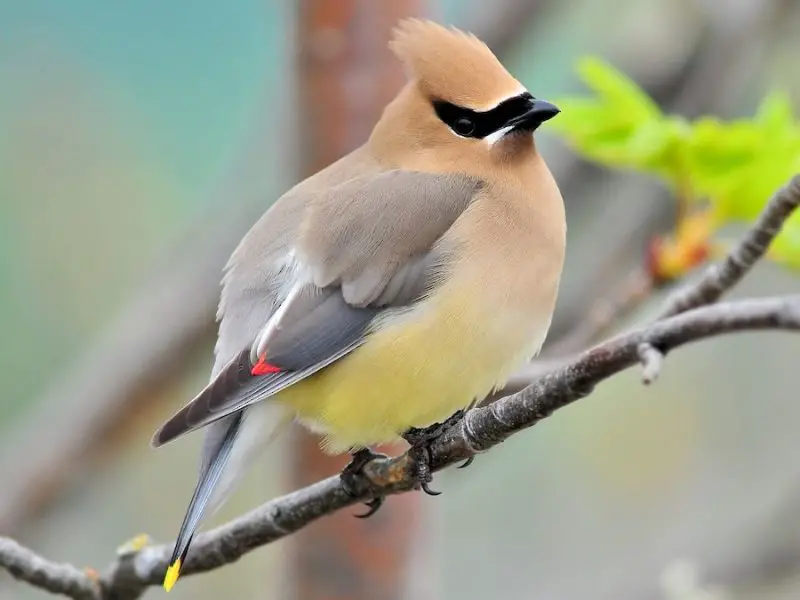
Cedar Waxwings are elegant birds with silky plumage, soft brownish-tan coloration, a crest, and a black mask outlined in white. They have pale yellow bellies and a yellow-tipped tail, with red wax-like tips on their secondary wing feathers. They measure about 6.3 to 8.3 inches long and have a slender build and short neck.
In Virginia, Cedar Waxwings are present year-round, but their numbers and locations shift depending on food availability. These birds are social, often found in flocks, and communicate with high-pitched, trilling calls. Their flight is swift and direct, and they often perch quietly in treetops before descending to feed.
Cedar Waxwings are highly frugivorous, relying on berries such as dogwood, cedar, serviceberry, and honeysuckle. In summer, they also consume insects, especially during breeding season. They inhabit woodlands, orchards, suburban areas, and riparian zones throughout Virginia, moving in nomadic flocks wherever fruit is abundant.
Common Yellowthroat

The Common Yellowthroat is a small, active warbler with a bright yellow throat and breast. Males sport a distinctive black facial mask bordered by white or gray, while females lack the mask and are more uniformly olive above. These birds measure about 4.3 to 5.1 inches long and have a rounded tail that’s often flicked.
They are widely distributed across Virginia during the spring and summer breeding season. Males sing a recognizable “witchety-witchety-witchety” song from cattails or low shrubs, especially at dawn. These warblers are secretive but energetic, often moving through dense vegetation near the ground.
Common Yellowthroats prefer wetland edges, marshes, brushy fields, and thickets. They are frequently observed in the Coastal Plain and Piedmont regions, as well as wet lowlands throughout the state. Their diet consists mainly of insects, including flies, beetles, grasshoppers, and caterpillars, which they hunt in thick cover.
Dickcissel
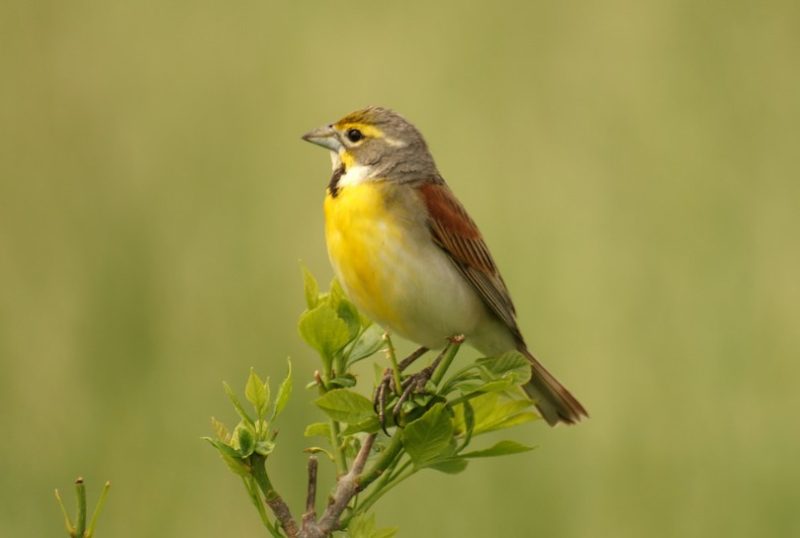
The Dickcissel is a sparrow-like bird with a chunky build and a thick, conical bill. Males are easily identified by their yellow breast, black throat patch, and grayish head with a yellow eyebrow stripe. Females and juveniles are duller and lack the bold black markings but still show hints of yellow. They measure about 5.5 to 6.3 inches in length.
In Virginia, Dickcissels are uncommon but appear in certain areas during spring and summer as breeding visitors. Males sing a sharp, repetitive “dick-dick-ciss-ciss” song from exposed perches like fence posts or tall grasses. These birds are often found alone or in loose groups, especially in fields and grassy habitats.
Dickcissels prefer open landscapes such as prairies, pastures, and overgrown agricultural lands. Their diet consists mainly of seeds and insects, which they forage for on the ground or in tall vegetation. In Virginia, they are most frequently reported in the western and central parts of the state during the breeding season, though their presence is irregular from year to year.
Eastern Meadowlark
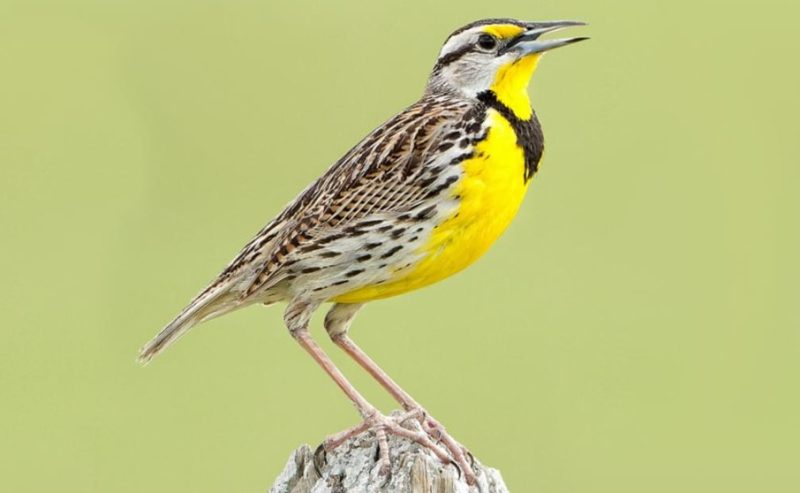
The Eastern Meadowlark is a medium-sized songbird with a stocky body, short tail, and long, slender bill. Its bright yellow chest is marked by a bold black “V,” and its back is heavily streaked with brown and black. They measure about 7.5 to 10.2 inches long and often stand upright with a conspicuous posture.
In Virginia, Eastern Meadowlarks are year-round residents, especially abundant in open grasslands and agricultural fields. Males sing a sweet, whistled melody from perches such as fence posts to defend territory and attract mates. These birds nest on the ground, creating well-hidden cup-shaped nests among thick grasses.
They forage primarily for insects during the breeding season—such as beetles, grasshoppers, and caterpillars—and switch to seeds and grains in fall and winter. They are found throughout the state, with healthy populations in the Piedmont and Shenandoah Valley, although loss of habitat has caused some local declines.
Evening Grosbeak

The Evening Grosbeak is a large, robust finch with a powerful bill. Males are striking, with a yellow body, bold white wing patches, dark head, and massive pale bill. Females are more subdued in gray with hints of green and yellow, but still show the same wing pattern. They measure around 6.3 to 8.7 inches in length.
In Virginia, Evening Grosbeaks are rare and irregular winter visitors, appearing mostly in northern and western regions during irruption years. Their arrival depends heavily on food availability in their northern breeding range. When present, they often travel in noisy flocks and visit backyard feeders stocked with sunflower seeds.
Their natural habitat includes coniferous and mixed forests, but during irruptions they are seen in suburban areas, parks, and woodlands. They feed on seeds, buds, berries, and insects. In Virginia, birders often spot them in the Appalachians or Blue Ridge during colder months, though sightings are unpredictable and highly seasonal.
Great Crested Flycatcher
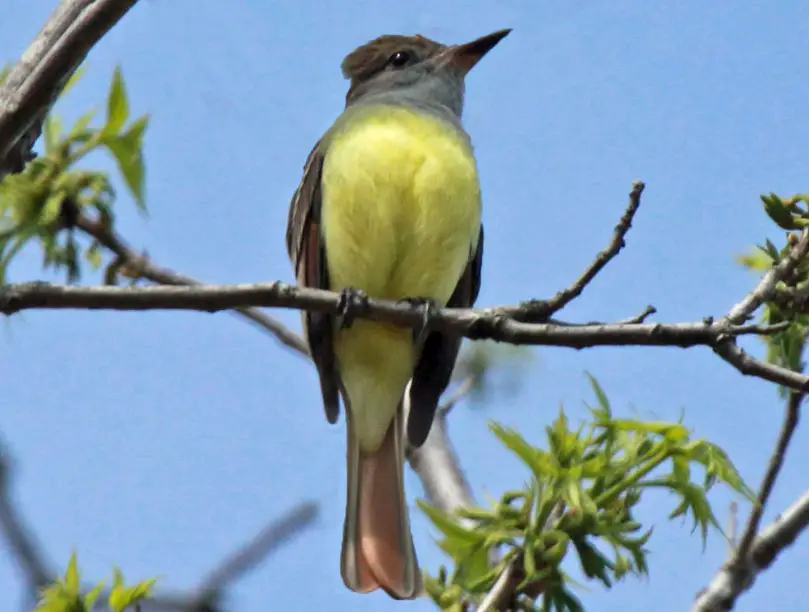
The Great Crested Flycatcher is a large, loud flycatcher with a grayish head and chest, a bright yellow belly, and warm brown upperparts. Its long tail and bushy crest give it a distinctive profile. This bird measures around 6.7 to 8.3 inches in length and has a bold, upright stance when perched.
In Virginia, Great Crested Flycatchers are common summer residents, typically arriving in late April. They nest in cavities, including old woodpecker holes or nest boxes, and are known to line their nests with snake skins or other unusual materials. Their loud “wheeep!” call often echoes through woodlands.
They forage by sallying out from high perches to catch flying insects such as beetles, moths, and butterflies. They also eat fruits, especially in late summer. These birds inhabit mature forests, woodland edges, and suburban areas with tall trees throughout Virginia, and are widely distributed across the state’s forests during breeding season.
Golden-winged Warbler
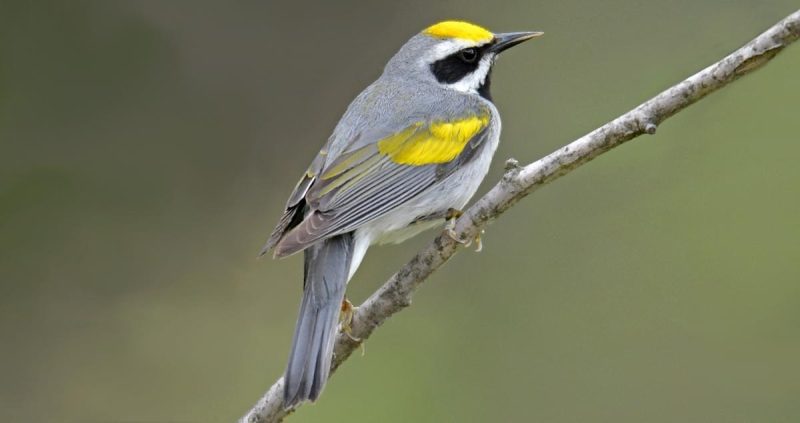
The Golden-winged Warbler is a small, striking warbler with a gray body, bright yellow crown and wing patches, and a sharp black throat and eye mask on males. Females are similarly patterned but duller, often with less defined black markings. They measure about 4.7 to 5.1 inches long and are known for their slim build and agility.
In Virginia, the Golden-winged Warbler is a rare and declining breeder, mostly found in isolated parts of the Appalachian Mountains. These warblers arrive in late spring and are typically found in shrubby, early successional habitats such as regenerating clearings, forest edges, or abandoned fields.
They forage actively for insects, gleaning caterpillars, spiders, and beetles from leaves and twigs. Their song is a high, buzzy “bee-bzz-bzz,” often heard from exposed perches. Habitat loss and hybridization with the Blue-winged Warbler have contributed to their decline, making them a conservation priority in western Virginia.
Hooded Warbler

The Hooded Warbler is a vibrant and unmistakable songbird, especially the male with its bright yellow face surrounded by a bold black hood and throat. The rest of the body is yellow underneath and olive-green above. Females are similar but lack the full black hood, appearing more muted. These birds measure about 5.1 inches in length and have a habit of flicking their tail to show white outer tail feathers.
In Virginia, Hooded Warblers are common summer residents in forested areas. They prefer mature deciduous forests with dense understory, especially near streams and wet ravines. Males sing a loud, ringing “ta-wit ta-wit ta-wee-tee-o” song from hidden perches, and they often remain well-concealed in leafy vegetation.
Their diet consists primarily of insects, including beetles, spiders, flies, and caterpillars. They forage close to the ground by hopping among low branches and shrubs. Hooded Warblers breed widely throughout Virginia, especially in the Piedmont and Appalachian regions, where forest conditions meet their habitat needs.
Kentucky Warbler
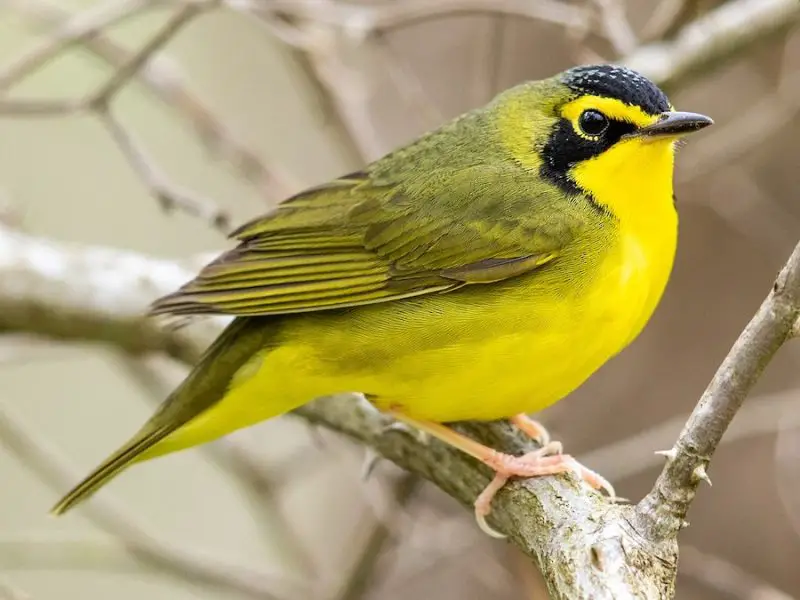
The Kentucky Warbler is a chunky, ground-dwelling warbler with olive-green upperparts and bright yellow underparts. One of its most distinctive features is its black crown and sideburns that frame a bold yellow face. This secretive bird is about 5.1 inches long and is more often heard than seen due to its preference for dense underbrush.
In Virginia, Kentucky Warblers are summer breeders and can be found in moist, deciduous forests with thick understory, especially near streams. Males sing a loud and rolling “churree-churree-churree” from hidden perches. They are known for walking or hopping through leaf litter rather than flying through the canopy like many other warblers.
These birds feed mostly on insects, spiders, and other small invertebrates, foraging low to the ground or on the forest floor. In Virginia, they are most commonly found in the central and southwestern regions during the breeding season, particularly where mature forest and understory cover are abundant.
Magnolia Warbler

The Magnolia Warbler is a small, colorful songbird easily recognized by its bright yellow underparts with bold black streaks, gray back, and black necklace across the chest. Males are especially vivid, while females and immature birds are duller but still show some streaking. They measure about 4.3 to 5.1 inches long.
In Virginia, Magnolia Warblers are mostly seen during spring and fall migration as they travel between their boreal breeding grounds and Central American wintering areas. These birds often forage in the lower to middle levels of trees, making them easier to spot during stopovers in parks and woodlands.
They feed primarily on insects such as caterpillars, beetles, and moths, using a combination of gleaning and flycatching techniques. While they don’t breed in Virginia, they pass through the entire state during migration, especially in forests, wooded swamps, and shrublands where insect prey is plentiful.
Myrtle Warbler (Yellow-rumped)
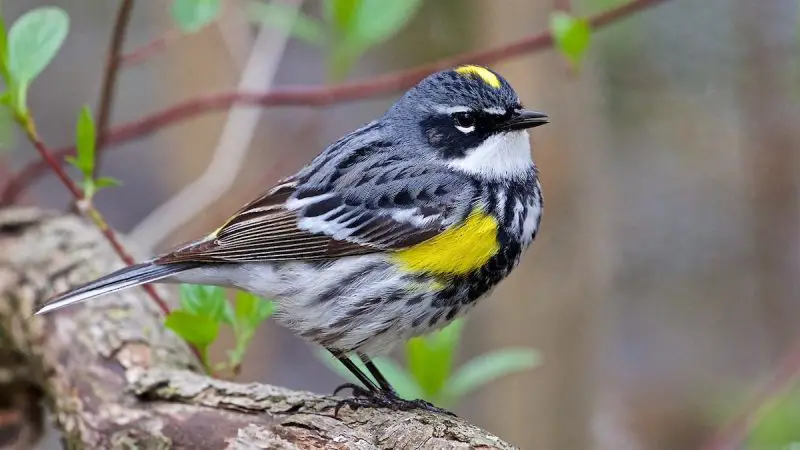
The Myrtle Warbler, a subspecies of the Yellow-rumped Warbler, is one of the most versatile and widespread warblers in North America. It has grayish upperparts, a white throat, yellow sides, and the distinctive yellow rump that gives the species its name. A yellow crown patch is also visible on some individuals. These birds are about 5.1 inches long.
In Virginia, Myrtle Warblers are very common during winter and migration seasons, found in a wide variety of habitats. They’re often seen flitting through shrubs, treetops, and even suburban yards. Their sharp “check” calls and fluttering foraging behavior make them easy to identify in mixed flocks.
Unlike most warblers, Myrtle Warblers can digest waxes from berries such as bayberry and wax myrtle, allowing them to overwinter farther north than many other warblers. In winter, they shift from an insect-heavy diet to one that includes more fruits and berries. They are widespread across Virginia from coastal areas to the mountains.
Nashville Warbler

The Nashville Warbler is a small and sleek warbler with a bright yellow underside, olive-green back, and a gray head. Males have a hidden rusty patch on the crown that’s rarely visible. They measure about 4.3 to 5.1 inches in length and are active foragers, constantly moving through foliage in search of prey.
In Virginia, Nashville Warblers are primarily seen during spring and fall migration. Though they breed farther north in boreal and mixed forests, they pass through the state regularly, especially in woodlands, parks, and shrubby habitats. Their song is a rapid series of high-pitched notes that are often heard during spring stopovers.
They feed on insects such as flies, beetles, and caterpillars, gleaning from foliage or making short flights to catch prey. During migration, they can be seen throughout Virginia, from the coastal plains to the mountains, often joining mixed-species foraging flocks.
Northern Flicker
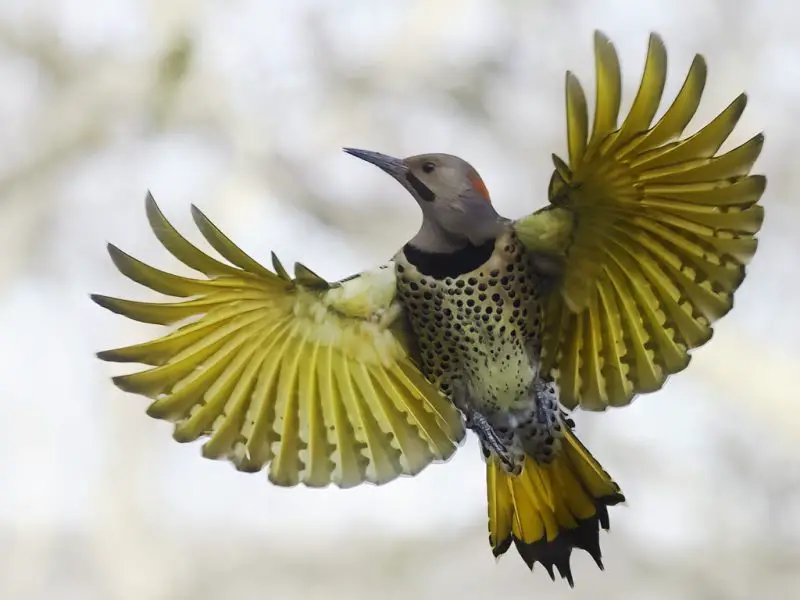
The Northern Flicker is a large, striking woodpecker with a brownish body, black-spotted underparts, and a black crescent across the chest. In the eastern U.S., including Virginia, it displays a yellow flash under the wings and tail. Males also have a black mustache mark. These birds measure about 11 to 12.2 inches in length and have a noticeable, slightly curved bill.
Northern Flickers are year-round residents in Virginia, often seen foraging on the ground—unlike most woodpeckers. They use their long barbed tongue to extract ants, their favorite food, from the soil. Their distinctive “wick-a-wick-a-wick” call and loud drumming make them easy to detect, especially during the breeding season.
They inhabit open woodlands, forest edges, parks, and suburban yards across the state. While they will nest in tree cavities like other woodpeckers, they are just as likely to be seen on lawns or fields searching for insects. In addition to ants, they eat beetles, fruits, and seeds, making them adaptable to a range of environments.
Northern Parula

The Northern Parula is a small, colorful warbler with a bluish-gray back, yellow throat and chest, and a green patch on the back. Males often show a reddish-brown band across the chest. This bird is about 4.3 inches long and features two white wing bars and a short tail, giving it a compact and agile appearance.
In Virginia, Northern Parulas are common summer breeders in moist, mature forests with plenty of Spanish moss or old man’s beard lichen, which they use to build their hanging nests. Males sing a buzzy, rising trill that ends abruptly—often described as a “zip!” sound. They are energetic foragers, moving quickly through treetops.
They feed primarily on small insects and spiders, gleaned from leaves or caught mid-air. Northern Parulas are found throughout much of Virginia in spring and summer, especially in the eastern and central parts of the state. They prefer bottomland hardwood forests and swampy areas with a well-developed canopy and epiphytes.
Orange-crowned Warbler
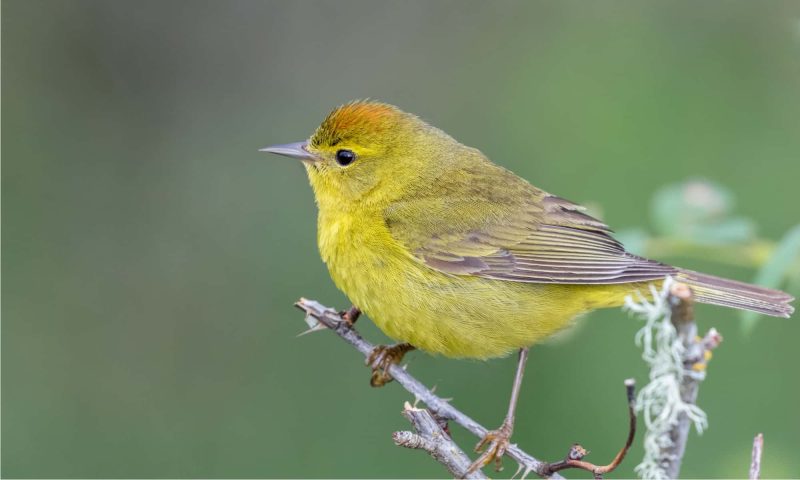
The Orange-crowned Warbler is a small, plain warbler with olive-green upperparts and yellowish underparts, though color can vary by region. As the name suggests, it has an orange crown, but this patch is usually hidden. It measures about 4.3 to 5.1 inches in length and is best identified by its faint eye line and overall drab appearance.
In Virginia, Orange-crowned Warblers are mostly seen during spring and fall migration, though a few may winter in the southeastern parts of the state. They are quiet and often forage low in shrubs or understory, making them harder to detect than more colorful warblers. Their call is a high, sharp chip, and their song is a simple trill.
They prefer thickets, woodland edges, and brushy fields while migrating. Their diet consists mainly of insects and spiders, but they also eat berries and nectar. During migration, they are scattered across Virginia, particularly in brushy habitats near forests or in parks and gardens.
Orchard Oriole (Female)
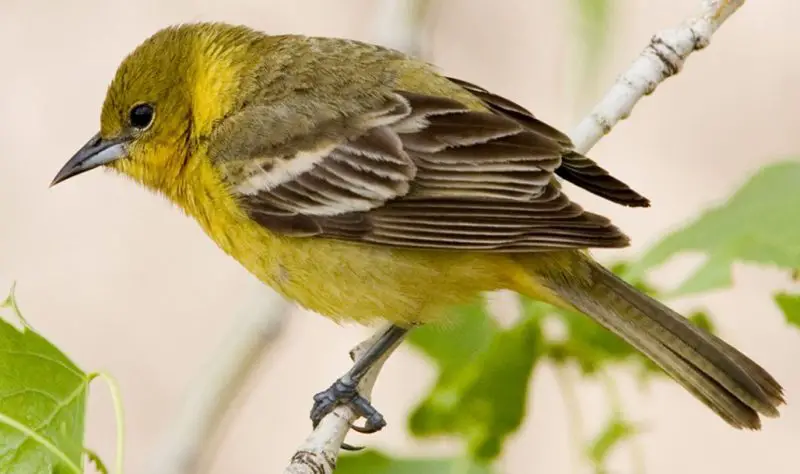
The female Orchard Oriole is a slim, medium-sized songbird with a warm yellow-olive body, duller wings, and a pale belly. Unlike the black and chestnut male, she is softly colored but still graceful and agile. These birds measure about 5.9 to 7.1 inches in length and have a slender, slightly curved bill.
In Virginia, Orchard Orioles are summer breeders, arriving in late April and nesting in open woodlands, orchards, river edges, and suburban areas. Females build hanging nests, often in isolated trees or along the edges of groves. They are more reserved than males but still active, foraging low in shrubs or trees.
Their diet includes insects, fruit, and nectar. Females are often seen picking caterpillars and beetles from foliage or sipping nectar from flowers. Orchard Orioles breed in scattered locations throughout Virginia, more common in the eastern and central regions where open landscapes and water sources are nearby.
Painted Bunting (Female)
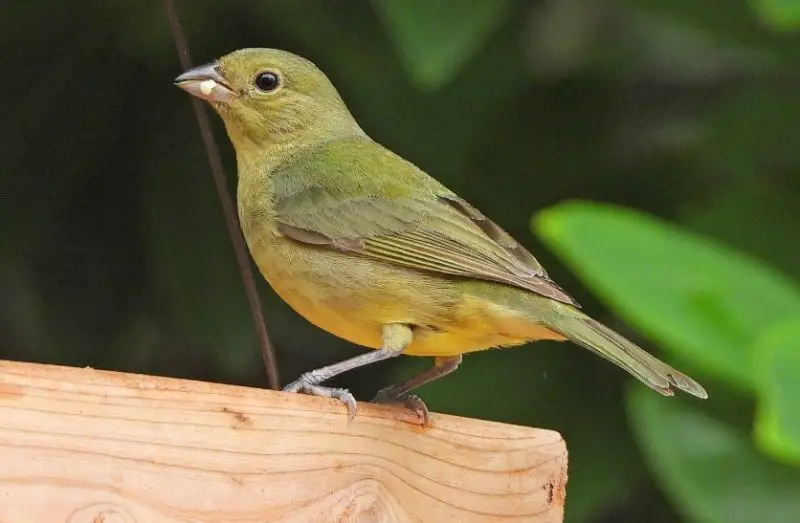
The female Painted Bunting is one of the few songbirds that combine subtle beauty with elusive behavior. She is mostly greenish-yellow all over, with a slightly paler belly and a finely pointed bill. While not as showy as the rainbow-colored male, she is elegant and blends easily into foliage. These birds are around 4.7 to 5.1 inches in length.
In Virginia, Painted Buntings are rare but occasional visitors, especially along the southeastern coast during migration or summer. Females tend to stay hidden in dense brush and are harder to spot than males. Their call is a soft, metallic “chip,” and they forage low in thickets and weedy fields.
They feed mainly on seeds and small insects. During the breeding season, females are responsible for nest building and raising the young, usually choosing dense vegetation for nesting. While Virginia is outside their core range, sightings of female Painted Buntings have occurred near the coast and barrier islands, especially in warmer months.
Palm Warbler
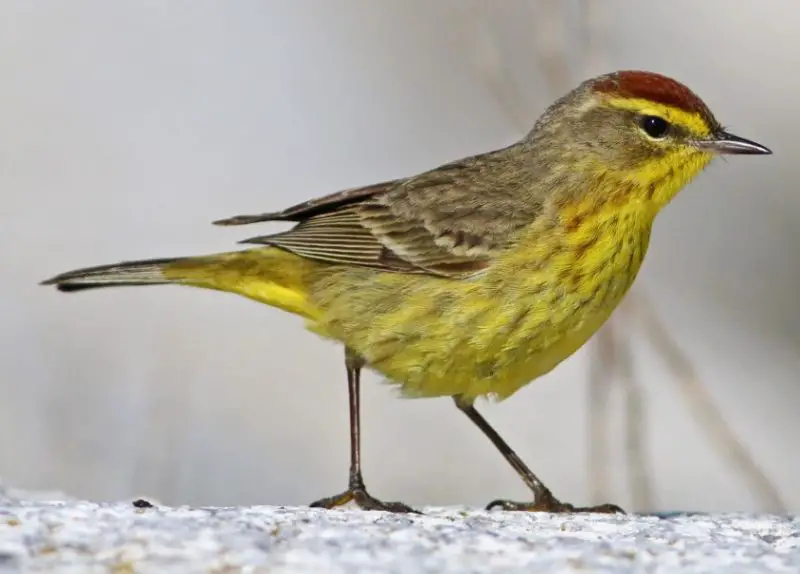
The Palm Warbler is a small, active warbler easily recognized by its constant tail bobbing and chestnut cap during breeding season. It has a yellowish underbelly, olive-brown back, and a distinct pale eyebrow. Measuring about 5.1 inches in length, this bird appears fairly drab overall, but its behavior makes it stand out.
In Virginia, Palm Warblers are primarily seen during migration in spring and fall, though small numbers overwinter in the southeastern part of the state. They often forage on the ground in open areas, walking or hopping rather than flitting like many warblers. Their call is a thin “tsip,” and their song is a weak trill.
They prefer open woodlands, field edges, grassy clearings, and weedy patches during migration. Insects make up the bulk of their diet—especially flies, beetles, and caterpillars—though they may also eat berries in winter. They pass through most regions of Virginia, especially the Coastal Plain and Piedmont during migration.
Pine Warbler
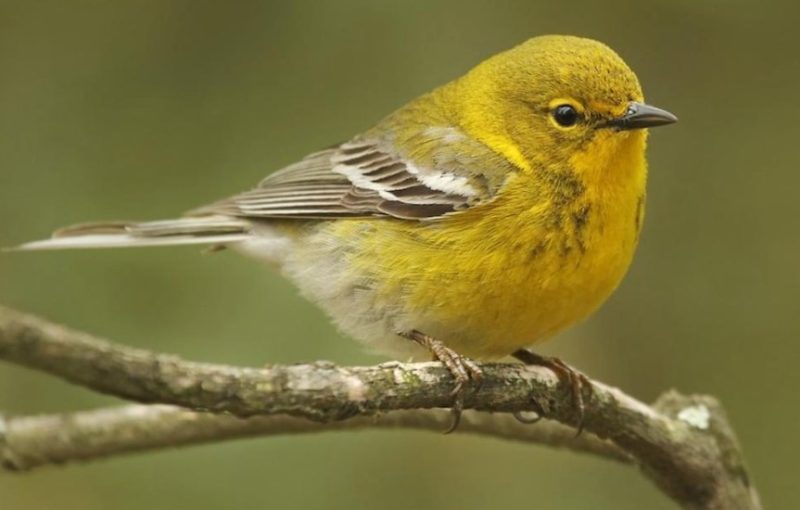
The Pine Warbler is a chunky, yellowish warbler with olive-toned upperparts, a slightly streaked breast, and two pale wing bars. It has a fairly thick bill compared to other warblers. Males are brighter yellow, while females and juveniles appear more muted. It typically measures about 5.1 to 5.5 inches in length.
In Virginia, Pine Warblers are among the few warbler species that can be found year-round, particularly in pine-dominated forests. They sing a musical trill that can be heard throughout the spring and summer from high in pine trees. These birds often stay higher in the canopy, though they may descend to feeders in winter.
They feed on insects, seeds, and occasionally suet. Unlike most warblers, Pine Warblers will visit bird feeders for cracked corn, sunflower seeds, and mealworms. In Virginia, they are widespread in pine woodlands across the state, from coastal forests to mountain ridges, especially where longleaf or loblolly pines are abundant.
Prairie Warbler
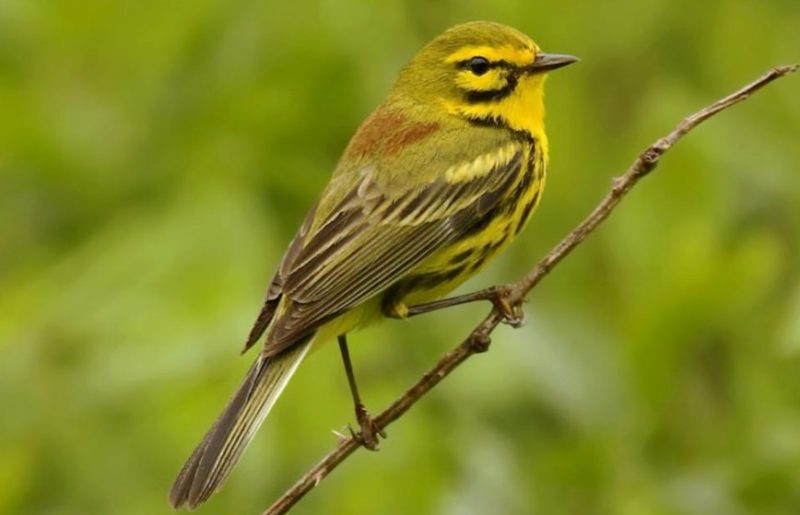
The Prairie Warbler is a small, slender bird with bright yellow underparts marked with black streaks along the sides and an olive back. A bold black line runs through the eye and another curves under it, creating a distinctive facial pattern. These warblers measure around 4.3 to 5.1 inches in length and often flick their tails while foraging.
Prairie Warblers are summer breeders in Virginia and prefer scrubby fields, regenerating forests, and shrubby edges—despite the name, they are not found in true prairies. Males sing a rising series of buzzy notes and can often be seen singing from the tops of small trees or shrubs in open areas.
They primarily feed on small insects and spiders, actively gleaning from foliage or making short flights to catch prey. Prairie Warblers breed in open, early-successional habitats throughout much of eastern and central Virginia, especially where young forests or abandoned fields provide the right structure.
Prothonotary Warbler
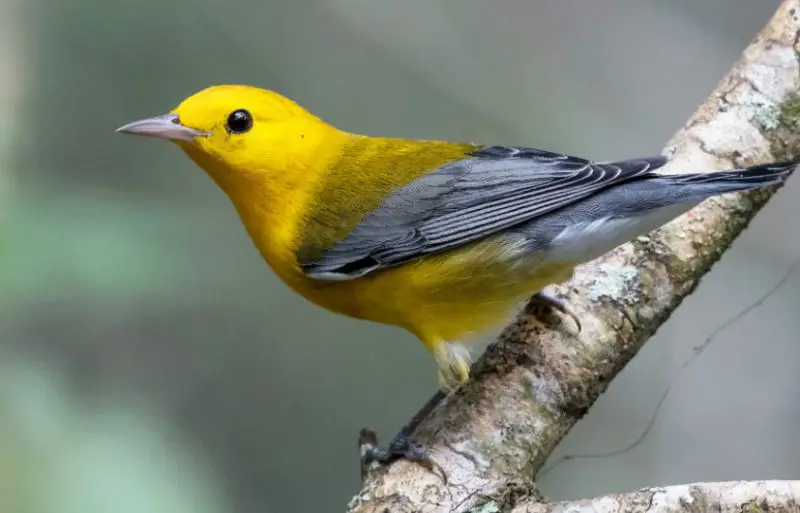
The Prothonotary Warbler is a brilliant yellow warbler with a blue-gray back, black beady eyes, and no wing bars. Males are especially bright, while females are slightly duller but still striking. This species measures about 5.1 inches in length and is often called the “swamp warbler” for its habitat preferences.
In Virginia, Prothonotary Warblers are common summer residents in swampy forests, river corridors, and wooded wetlands. They nest in tree cavities near water, often reusing old woodpecker holes or nest boxes. Males sing a loud, ringing “sweet-sweet-sweet-sweet” song to attract mates and defend territory.
They forage close to water, picking insects, spiders, and snails from vegetation. Occasionally, they hover to glean from leaves or probe bark. In Virginia, they are found primarily in the Tidewater and Coastal Plain regions, though they also breed in swampy parts of the Piedmont. Their preference for wetlands makes them especially vulnerable to habitat loss.
Scarlet Tanager (Female)
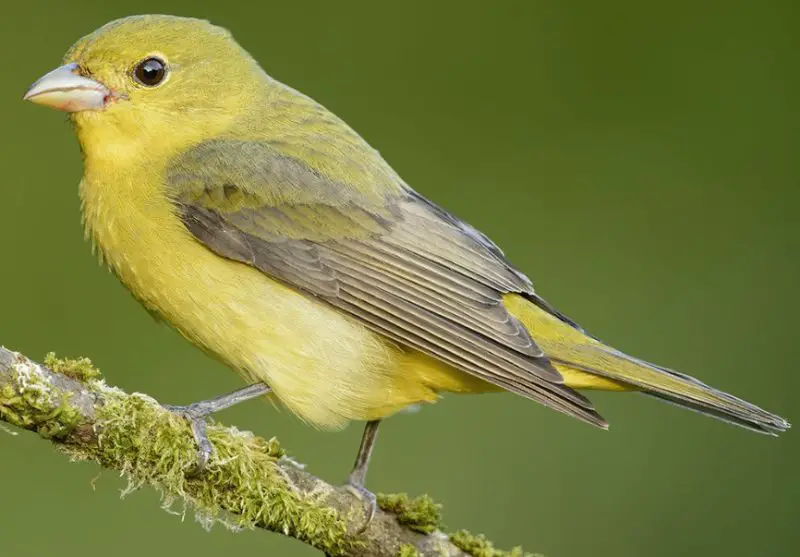
The female Scarlet Tanager is a soft olive-yellow songbird with darker wings and a stout, slightly hooked bill. While males are famous for their brilliant red plumage, females have a more subtle beauty and are often mistaken for other species. They measure around 6.3 to 6.7 inches in length and have a smooth, unmarked appearance.
In Virginia, Scarlet Tanagers are summer breeders, especially in mature deciduous forests. Females are quieter than males but can be heard giving a short “chip-burr” call while foraging high in the canopy. They are deliberate movers, searching through leaves for prey or catching insects in midair.
Their diet includes caterpillars, beetles, wasps, and various berries. Scarlet Tanagers prefer large tracts of undisturbed forest, and females often remain well-hidden in the foliage. In Virginia, they are widespread in the Piedmont and mountain regions during the breeding season, where suitable forest habitat exists.
Summer Tanager (Female)
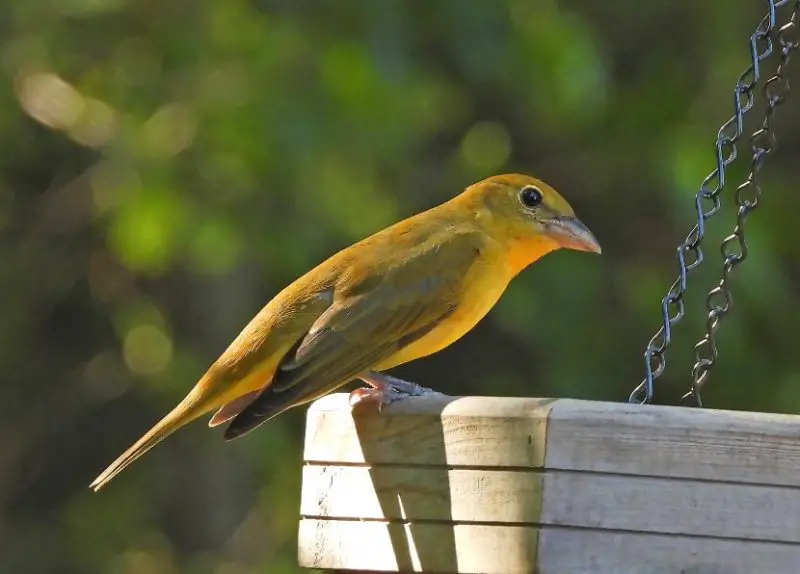
The female Summer Tanager is a warm yellow to olive-yellow bird with a thick, slightly hooked bill. Unlike the brilliant red males, females have a softer, more subtle coloration, making them somewhat harder to spot. They measure about 7.1 to 8.3 inches in length and have a robust, chunky build typical of the Tanager family.
In Virginia, female Summer Tanagers arrive in late spring and breed primarily in mature deciduous forests, often near water. They are known for their gentle “chuck” calls and slow, deliberate movements while foraging high in the tree canopy. Females build nests of twigs and grasses, usually well concealed in leafy branches.
Their diet consists mainly of large insects such as bees, wasps, and hornets, which they catch in flight or pluck from foliage. Occasionally, they also consume fruit during late summer. Summer Tanagers are most commonly found in the Piedmont and southwestern regions of Virginia during the breeding season.
Western Kingbird
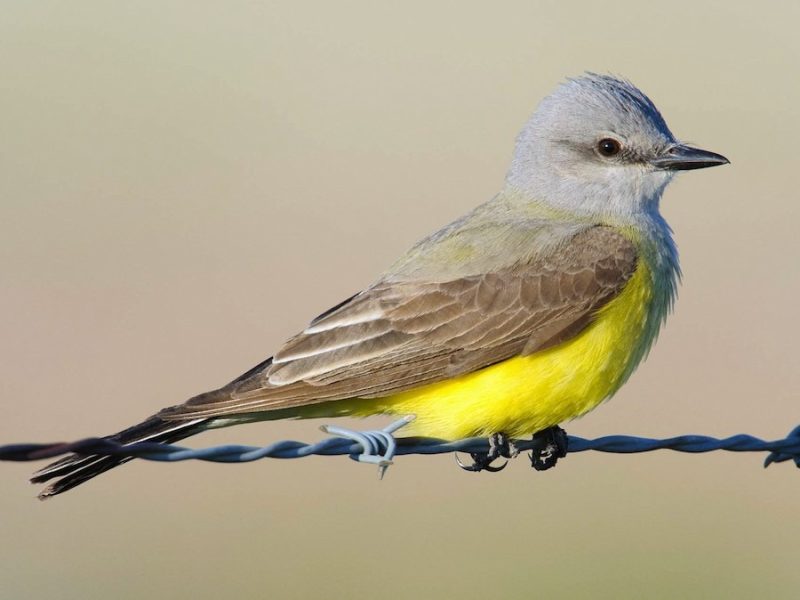
The Western Kingbird is a medium-sized flycatcher with a gray head, pale yellow belly, and bright yellow underparts contrasted by a darker gray back and tail with white edges. It measures about 8.3 to 9.1 inches long and has a strong, slightly hooked bill ideal for catching flying insects.
In Virginia, Western Kingbirds are rare vagrants but occasionally appear during migration or in late summer. They are active and aggressive hunters, often seen perched on exposed wires or fence posts from where they sally out to catch insects mid-air. Their call is a sharp, repetitive “kip-kip-kip.”
They prefer open habitats such as grasslands, agricultural fields, and open woodlands where they can hunt flying insects. Though uncommon in Virginia, sightings have been reported mostly in the western and central parts of the state during migration periods.
White-eyed Vireo

The White-eyed Vireo is a small songbird with olive-green upperparts, white underparts, and striking white “spectacles” around its red eyes. It has two white wing bars and a short tail, measuring about 4.7 to 5.5 inches in length. Its bright eyes and sharp, chipping call make it distinctive.
In Virginia, White-eyed Vireos are common breeders found in dense thickets, shrubby fields, and woodland edges. Males sing a loud, complex series of phrases and whistles to defend territory. They are secretive and often remain hidden in thick vegetation, making them more often heard than seen.
Their diet primarily consists of insects and spiders, which they actively glean from leaves and branches. White-eyed Vireos breed throughout Virginia, especially in the Piedmont and Coastal Plain regions, favoring areas with dense low growth and abundant insect prey.
Wilson’s Warbler
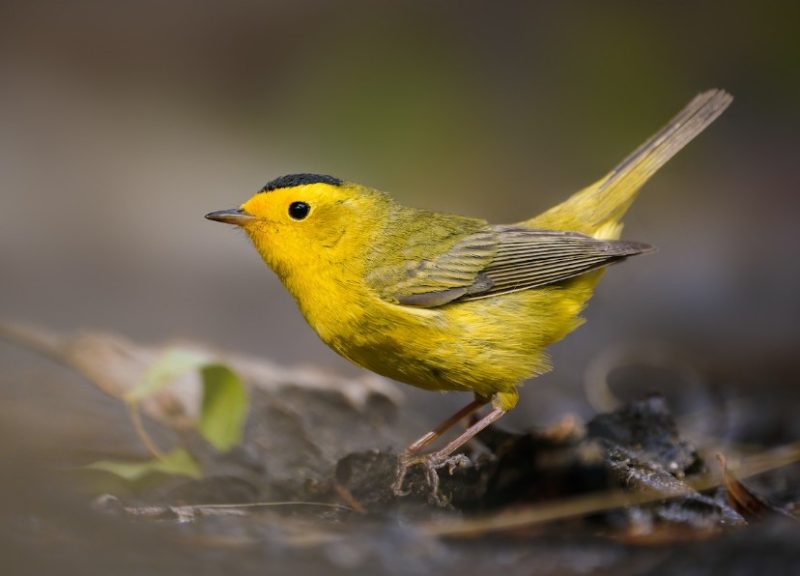
Wilson’s Warbler is a small, lively songbird with bright yellow underparts and olive-green upperparts. Males have a distinctive black cap on their heads, while females and juveniles have a less pronounced or absent cap. They measure about 4.3 to 4.7 inches in length and have a rounded tail.
In Virginia, Wilson’s Warblers are primarily spring and fall migrants passing through the state. They prefer shrubby thickets, woodland edges, and moist brushy areas during migration stopovers. Their song is a rapid, bubbly trill, and their call is a sharp “chip” note.
They feed mainly on small insects and spiders, foraging actively in dense low vegetation. Although they do not breed in Virginia, they are fairly common migrants throughout the state, especially in the coastal and piedmont regions during spring and fall.
Yellow-breasted Chat
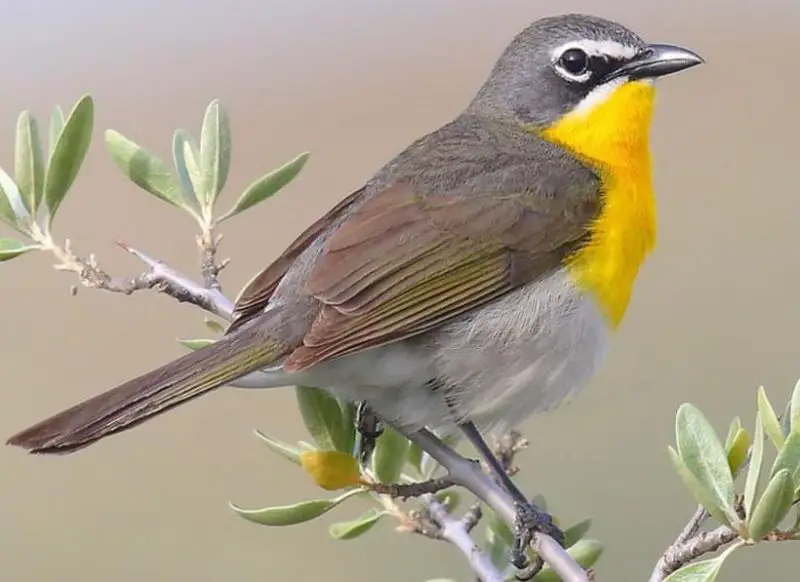
The Yellow-breasted Chat is a large, chunky songbird notable for its bright yellow chest, white “spectacles” around the eyes, and olive-green back. Measuring about 7.1 to 7.9 inches in length, it is the largest member of the wood-warbler family and often mistaken for a sparrow due to its size and robust body.
In Virginia, Yellow-breasted Chats are summer residents found in dense, brushy habitats such as thickets, overgrown fields, and forest edges. Males sing a loud, varied, and often complex song that includes whistles, gurgles, and chatters. These birds are shy and secretive, often remaining hidden in thick vegetation.
Their diet mainly consists of insects like beetles, caterpillars, and grasshoppers, supplemented by berries and fruit in late summer and fall. They forage low in dense shrubs and thickets across much of Virginia, especially in the Piedmont and Coastal Plain regions during the breeding season.
Yellow-headed Blackbird
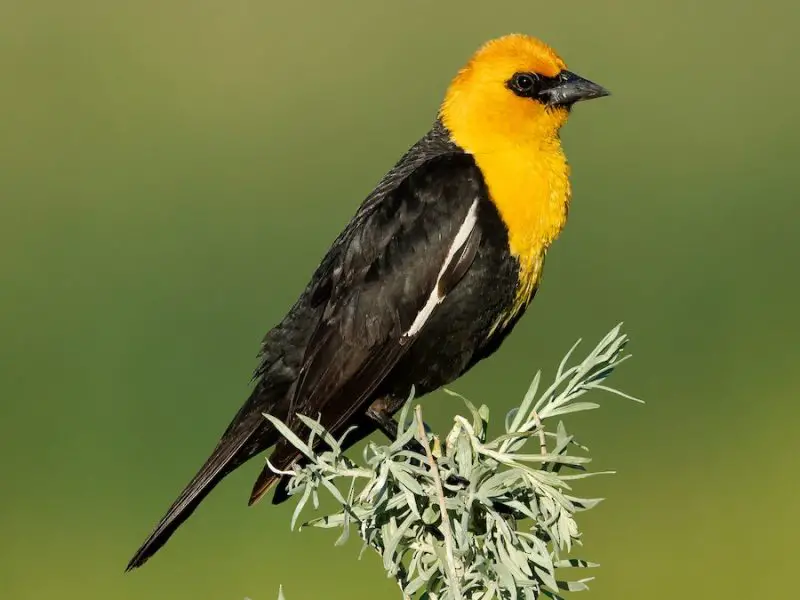
The Yellow-headed Blackbird is a striking blackbird species with a bright yellow head and chest contrasting sharply with glossy black wings and body. Males are the most colorful, while females are duller with more brownish plumage but still show yellow on the head and chest. They measure about 9 to 10 inches long, making them larger than many blackbird species.
In Virginia, Yellow-headed Blackbirds are rare visitors, mainly appearing during migration or in winter. They are typically found in marshy or wetland habitats, often mixing with Red-winged Blackbirds and other blackbird species. Their calls include harsh, raspy notes and a distinctive, ringing song.
Their diet consists mainly of seeds, grains, and insects, which they forage from marsh vegetation or open fields. Due to their rarity in Virginia, sightings are notable but infrequent, mostly reported in wetland areas along the Coastal Plain.
Yellow-throated Vireo
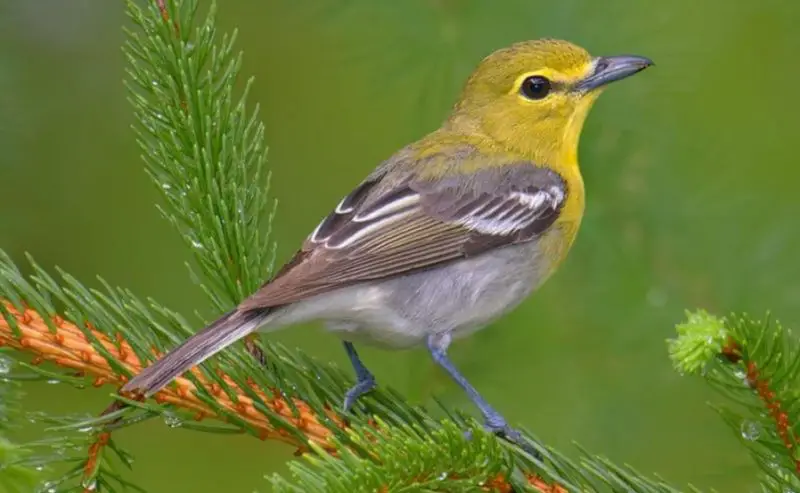
The Yellow-throated Vireo is a medium-sized, brightly colored songbird with olive-green upperparts, bright yellow throat and chest, and white wing bars. It has a stout, slightly hooked bill and measures about 5.5 to 6.3 inches in length. Its cheerful song is a series of clear, whistled notes.
In Virginia, Yellow-throated Vireos are common summer breeders found in mature deciduous and mixed forests, especially near streams and wooded slopes. Males sing persistently to defend territory and attract mates, often from high perches within the canopy.
They feed mainly on insects and spiders, gleaning them from leaves and branches, and sometimes taking fruit during late summer. These vireos prefer large tracts of forest with well-developed canopies and are widely distributed across Virginia during the breeding season.
Yellow-throated Warbler
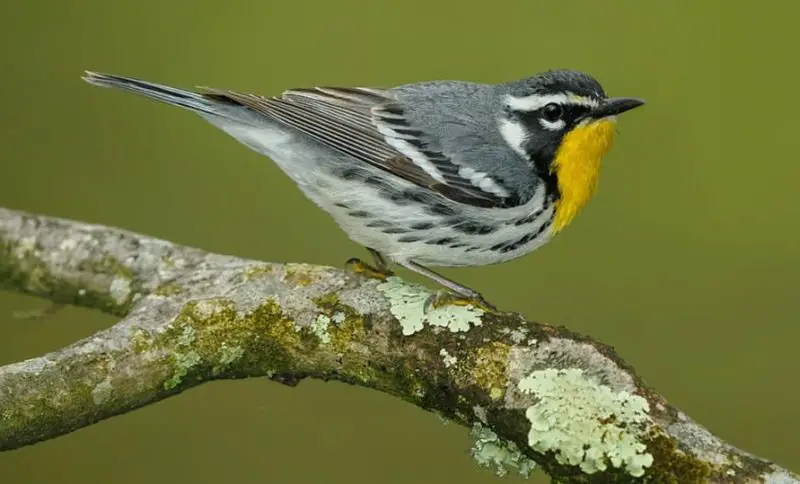
The Yellow-throated Warbler is a striking warbler with a bright yellow throat and chest, gray back, and bold black-and-white streaking on the face and wings. Males are especially vibrant, while females may be slightly duller but retain the key yellow markings. They measure about 5.1 inches in length.
In Virginia, Yellow-throated Warblers breed primarily in mature pine and mixed forests, often near streams or swampy areas. Their song is a clear, ringing series of descending whistles, frequently heard from high treetops. These birds are active and agile, gleaning insects from pine needles and bark.
Their diet consists mainly of insects such as caterpillars, beetles, and spiders. Yellow-throated Warblers are most commonly found in the Piedmont and Coastal Plain regions of Virginia during the breeding season, favoring pine-dominated woodlands and river corridors.

